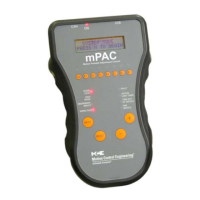Motor, Brake, and Encoder Connection
2-11
2
Motion 4000
Motor, Brake, and Encoder Connection
Verify that power to the controller has been shut off at the main disconnect before proceed-
ing with connections.
Motor Connection
If you are reusing an existing hoist motor, you must check it for insulation breakdown
before proceeding. Applying power from a modern drive to a motor with insulation prob-
lems can damage the motor and/or the drive.
Insulation Breakdown Test
1. Disconnect all motor and brake wiring.
2. Perform an insulation test between motor and brake connection points and the body of
the motor. Use a Megohm meter to subject the insulation to the same high voltage that
would be present during elevator operation.
3. A minimum insulation resistance of 100k Ohms is required.
4. Correct any insulation problems before proceeding with installation. Insulation prob-
lems may indicate a serious problem in the equipment.
Motor Wiring
Incoming power to the controller and outgoing power wires to the motor must be through sepa-
rate grounded conduits.
1. Refer to the power section drawing in your job prints.
2. Use a shielded power cable between the motor drive and the AC Motor stator connec-
tions to reduce RFI/EMI noise (Siemens Protoflex - EMV or equivalent). The shield
must be terminated to earth ground at both ends.
3. Make connections as shown. Be sure to follow any notes regarding wire sizes.
4. Pay particular attention to motor grounding instructions in the job prints and in the
motor manufacturer instructions.
MRL or Extended Motor Cables
If cables from the drive to the motor are over forty feet / 12 meters in length, high voltage peaks
or high rates of voltage rise can occur on the motor windings, potentially damaging the motor.
In these installations, a special output filter may be recommended by the drive manufacturer.
Both cable length limitations and filter configuration are dependent on the drive. Refer to the
drive manufacturer manual for specific information and treatment.

